IT service management (ITSM) is the most widely used model for managing IT resources. Designed to cater to the growing demands of an organization in terms of both everyday and future operations, ITSM involves implementing and maintaining IT services to improve internal work processes and provide better service for customers.
If you’re completely new to IT service management, you’re in the right place. After reading this in-depth introduction, you’ll have a thorough grasp of exactly what ITSM is, whether it’s the right choice for your firm and how to choose the best ITSM to achieve your business goals.
What is IT service management?
IT service management is the way IT departments manage the delivery of IT services from within their team to their customers. The term covers all the activities and processes involved in designing, creating, delivering, supporting and managing IT services.
To better understand ITSM, you need to grasp what IT services are. Everything your IT team provides, from the apps installed on your workplace smartphone to the printer your department uses, is an IT service.
It’s easy to think IT service management begins and ends with IT support, because that’s the service most users are familiar with. But the reality is that ITSM stretches far beyond solving everyday issues.
The core idea behind ITSM is that IT should be provided as a service. For example, if an employee wanted a new computer monitor, the ITSM process would work this way:
- The employee would submit a ticket through a portal with their request.
- The ticket would be delivered to the IT team’s queue, where it would be prioritized according to urgency.
- The IT team would address the ticket and approve the request.
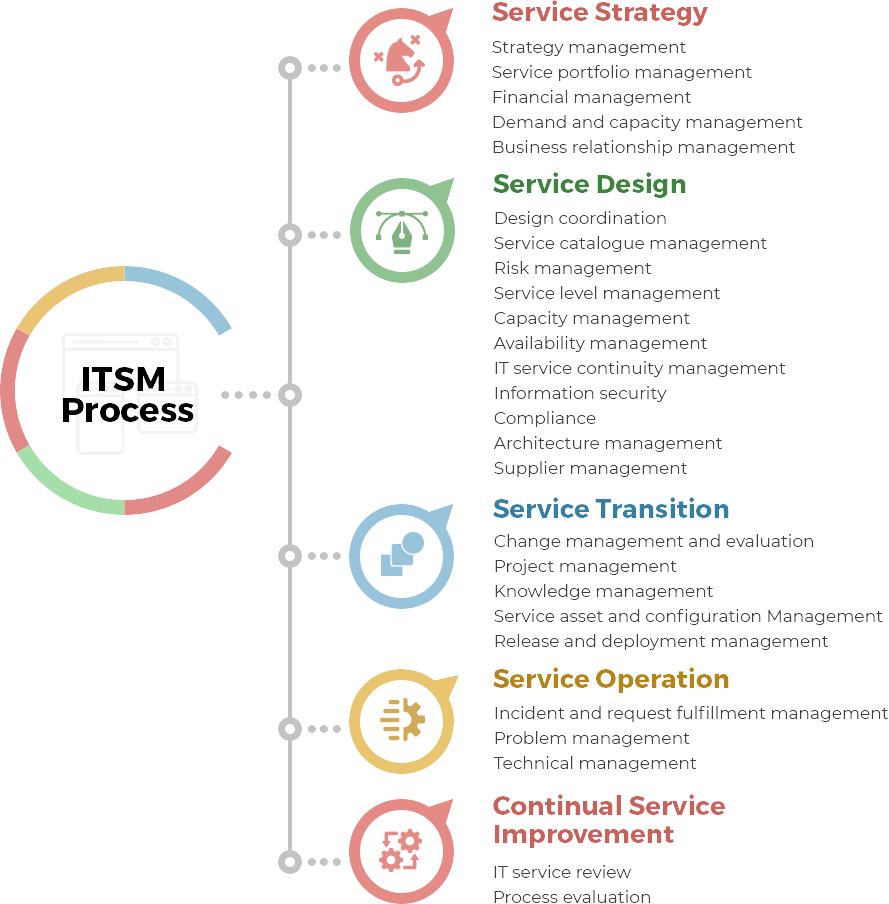
A breakdown of the ITSM Process. Credit: manageengine.com
ITSM vs ITIL vs DevOps
Knowing the difference between ITSM, ITIL (Information Technology Infrastructure Library) and DevOps (Development Operations) is essential according to Redtech. These key terms are three of the most influential frameworks for modern IT teams and if implemented correctly, can create a solid triangle infrastructure to strengthen and benefit the entire organization.
ITSM
As defined above, IT service management is the way IT teams manage the delivery of their IT services to their customers. An IT department’s ITSM concept can be influenced by a DevOps approach and be designed to align with ITIL practices.
ITIL
The most universally accepted approach to ITSM, ITIL coordinates IT services with business needs. Information technology infrastructure libraries can help firms adapt to continuing transformation and scale.
The latest version of the concept, ITIL 4, introduced a paradigm shift for IT teams. The most recent update supports a more agile approach by encouraging a holistic, business and customer-value architecture, promoting simplicity, collaboration and feedback.
ITIL is sometimes misunderstood as being a set of rules rather than a guide that’s open for interpretation. While it’s true that processes need to be followed and clear documentation needs to be kept, there’s no excuse for hiding behind the ITIL rules. They’re designed to be flexible and flow according to how your organization works.
DevOps
DevOps enhances the relationship between software development and IT operations, allowing firms to build, test and deploy software quickly and reliably. Some of the benefits include greater levels of trust between teams, faster software releases, improved management of unplanned work and a shorter time to resolve critical problems.
Bringing together teams which have traditionally functioned in separate silos, DevOps improves group collaboration to create continuing development, deep integration and automated delivery.
ITSM and DevOps are often viewed as being mutually exclusive, but this simply isn’t true. Many high performing teams understand the need to be able to work smarter and faster, while still relying on process and control to maintain workflow.
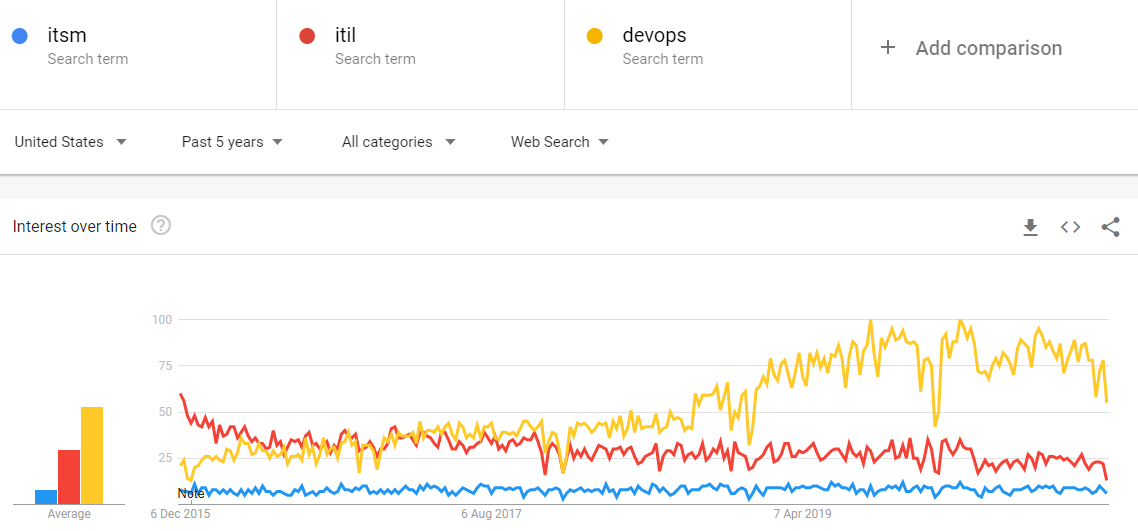
As per Google Trends, search interest for DevOps has been steadily growing over the last five years. In comparison, search interest for ITSM has stayed level, while the search interest for ITIL has dropped.
Why is IT service management important?
There are many reasons implementing IT service management is important for businesses. By following a process-orientated technique, ITSM gives IT teams the control they need to take a methodical approach to service management. At the same time, it increases accountability and transparency of the IT department, empowering them to put new functionalities into action to boost customer satisfaction.
ITSM greatly benefits your IT team and your entire organization as a result. But as with anything, you’ll also find a few disadvantages if you look hard enough. Here’s a list of the pros and cons of IT service management.
Pros and cons of ITSM
Pros
- Offers the ability to align IT teams with business goals and priorities, supporting the entire organization.
- Creates trackable metrics you can use to analyze success and change tactics.
- Introduces cross-department collaboration for improved relationships and streamlined services.
- Encourages IT operations and development teams to work together through the use of modern project management frameworks for hassle-free collaboration.
- Enables IT teams to continuously improve and share knowledge with other teams, benefitting multiple departments.
- Enhances request coordination to create a more efficient service for customers.
- Empowers customers with a focus on self-service processes to help them get back to work faster.
- Resolves major incidents quickly for the smooth functionality of the organization.
- Provides the ability to plan ahead, predicting and preventing future incidents.
- Reduces costs and provides a predictable pricing structure you can use for budgeting.
Cons
- Large firms that are continually expanding their business operations often have problems with scalability.
- Some ITSM approaches aren’t compatible with selected IT operation structures and software.
- Often seen as an indoctrinated approach and implemented with little planning and no goals.
Overall, IT service management can be incredibly beneficial for almost any organization. Even taking into consideration the potential disadvantages of ITSM, any major problems envisaged can often be resolved in the planning stage.
If your firm is constantly expanding its existing business operations, it’s likely adopting ITSM will undermine the organizational objectives in the long run. In this case, it’s best to carry on as you are and wait until there’s a quiet period to implement ITSM.
Any potential compatibility issues in terms of software or business frameworks can be researched before implementation. If workflow allows it, firms can switch from current problematic software or frameworks to ITSM-compatible software or frameworks, as the benefits often outweigh the hassle.
There’s no point in adopting modern processes just because everyone else is doing it. Implementing IT service management won’t turn any organization into an IT service delivery and support rockstar overnight. IT services need to be aligned with business goals and implemented through the proper channels to be effective.
ITSM practices
Previous ITIL versions listed recommended processes. But ITIL 4 shifted from this previous framework to introduce 34 ITSM practices. The aim of the updated terminology was to allow the consideration of culture, technology, information and data management, resulting in a holistic vision of workflow. This improved approach better reflects the way modern firms work.
In reality, the terminology doesn’t matter. What does matter when it comes to IT service management is that IT departments use organizational resources and follow procedures that can easily be repeated in order to deliver a consistent, reliable and efficient service. Taking advantage of practices and processes is one of the primary aspects which distinguishes IT from ITSM.
Here are some of the most important ITSM practices:
Service request management
Service request management refers to a repeatable process for managing various customer service requests, such as asking for access to applications, software updates and hardware improvements. The service request framework deals mostly with recurring requests and is designed to benefit customers by empowering them with knowledge to solve simple issues themselves, as well as automating specific jobs.
Knowledge management
Knowledge management involves creating, sharing, using and managing all data, information and knowledge of a firm. It leverages a multidisciplinary approach to accomplishing organizational goals by taking advantage of the knowledge available.
IT asset management
IT asset management (ITAM) ensures that the organization’s valuable items, both tangible and intangible, are tracked and being used. This practice helps the firm not only know where all their assets are at all times, but also makes sure they’re maintained, upgraded and disposed of when necessary.
Incident management
With firms relying on so many different pieces of software today, there’s more potential failure points than ever before. Incident management guarantees all unforeseen issues are responded to and resolved as quickly as possible, to get services back into their operational states.
Problem management
While incident management involves fixing issues, problem management refers to determining and managing the underlying causes of incidents on an IT service. It strives to discover and implement the best methods in order to remove the root causes of various incidents.
Change management
Change management establishes standard procedures for the fast and efficient handling of changes made to the IT architecture. These changes include launching new services, managing current services and resolving issues in the code. The best change management incorporates context and transparency to reduce congestion while minimizing risk at the same time.
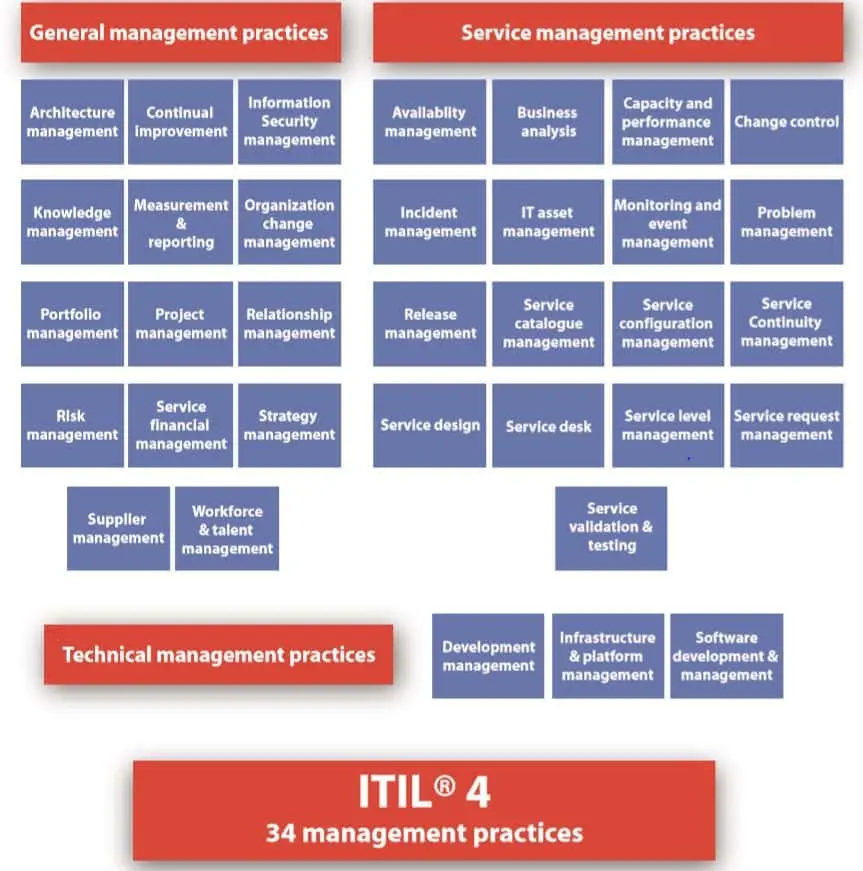
The 34 management practices of ITIL 4. Credit: knowledgeapple.com
How your organization can benefit from ITSM
There are three main ways your organization can benefit from IT service management: by increasing IT efficiency, increasing business efficiency and reducing waste. This is how implementing an ITSM framework could directly benefit your organization.
Increase IT efficiency
- Process workflow — create a technology-enabled process workflow to replace manual processes, improving collaboration between numerous departments.
- HR productivity — reduce the admin workload and waiting times of scarce IT human resource teams, increasing time for more strategic work.
- Service-based incident management — prioritize incidents and estimate the resolution time based on the business impact.
- Save time and money — optimize problem management and knowledge management to cut down on recurring problems, resolution times and the implications for end users and businesses overall.
- Intelligent reports — automate report generation to reduce reporting time and costs.
Increase business efficiency
- Decrease downtime — incident, problem and availability management result in increased business uptime.
- Predict and prevent future issues — prevent problems which would seriously harm the organization through efficient problem management and capacity management.
- Fast recovery times — implications of major issues can be mitigated through IT service continuity and incident management.
Reduce waste
- Improve efficiency — reducing wastage and avoiding accidental work duplication saves organizations time, effort and unnecessary costs.
- Optimized budget— use asset, configuration and capacity management to guarantee any new IT spending is essential for the business.
- Eliminate duplicate or obsolete asset costs — efficient asset management removes the unnecessary cost of duplicate applications, hosting, hardware and the support needed to maintain them.
- Redeploy underused assets — eliminate underutilization of hardware and software by tracking their location and use.
- Reduce inconsistency-related or change-based waste — avoid the cost of reworking mistakes which is often double, or even triple, the effort.
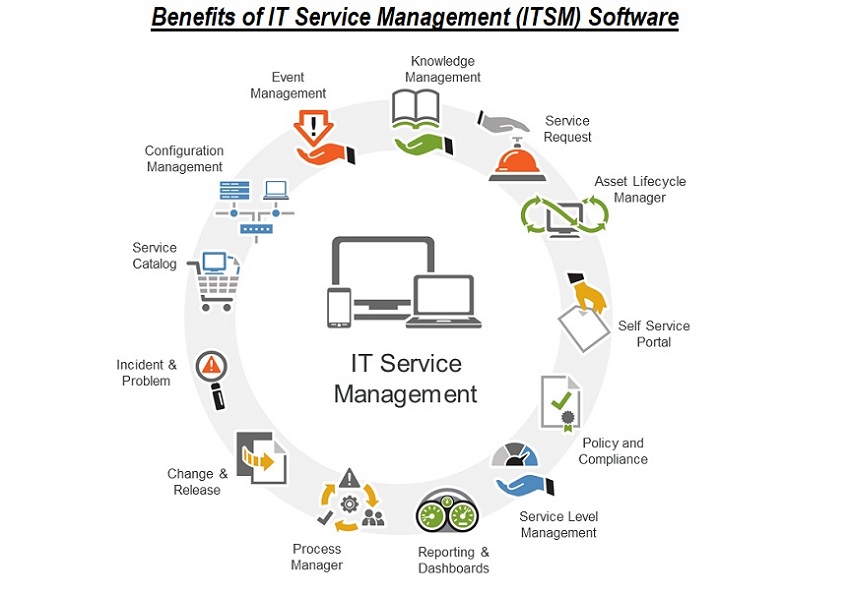
Benefits of ITSM software. Credit: techglobex.net
How to choose the best ITSM
The needs of each business are very different and because of that, different businesses work best with different IT service management frameworks. When looking to implement a new ITSM, take the following steps into consideration.
Review your ITSM requirements
An ITSM infrastructure is designed to keep your organization running smoothly. Therefore, it’s essential to review which processes are vital to your operations. Begin by breaking down your daily requirements, listing consistent issues and identifying slow, cumbersome processes which could be automated for increased efficiency.
Ask staff
To help you with the previous point, ask the people who will be using the service what they need. IT staff should definitely be included in the process, as should a focus group made up of select employees from various departments. Ask which features they would find most useful to help you choose an ITSM that will benefit everyone using it.
Prioritize your list
It’s important to remember that desires aren’t the same as requirements. Review the list and ensure it’s aligned with the needs of your firm and its end users. Separate the features which are essential for the base level of functioning from the aspects which would be useful, but not crucial.
Plan for integrations
For ITSM to be a success, it needs to integrate seamlessly with the software and framework your organization currently uses. For example, if you use a lot of cloud-based services, your new ITSM needs to be cloud-compatible.
Set a budget
While it shouldn’t be the first thing you consider when choosing an ITSM, you do need to factor cost into the equation. Set a budget at the start then calculate the total cost of potential IT service management frameworks over the course of five years when doing your research. Ensure the calculated costs cover all the features you require and possible issues which could incur extra costs, such as upgrades and maintenance.
Important ITSM metric to measure
To understand if something is working, you need to be able to measure its effects. You can’t measure everything, otherwise you’ll find yourself inundated with useless information. You need to measure the right metrics to determine the efficiency of ITSM. Here are some of the most important IT service management KPIs to monitor:
- Incidence response time — time between when an incident is reported and its successful resolution.
- First-touch resolution rate — percentage of incidents resolved the first time.
- Service level agreement compliance ratio — ratio of resolutions that fulfilled service level agreement (SLA) guidelines in relation to response time, workflow priority, cost and additional metrics.
- Cost per ticket — amount of money spent resolving each incident.
- Number of active tickets — number of reported incidents yet to be resolved.
- Recategorized incidents — incident misdiagnosed at creation and had to be reclassified.
- Reopen rate — percentage of tickets that need to be revisited after being marked as resolved.
- Incidents per department — number of tickets initiated by each department.
- Incidents by type — incidents categorized by problem device or application.
- Incidents not initiated via self-service — tickets opened by phone calls, emails, in-person or any other method aside from a self-service portal.
- Incidents with associated problems — incidents reported that are associated with already known problems.
- Escalated incidents — tickets which had to be resolved by level 2 or level 3 members.
- Incidents resolved remotely — incidents resolved without the need of an in-person visit by a technician.
- Incidents with no known resolution — number of tickets which can’t be resolved.
- Ticket volume — total number of tickets over a given time.
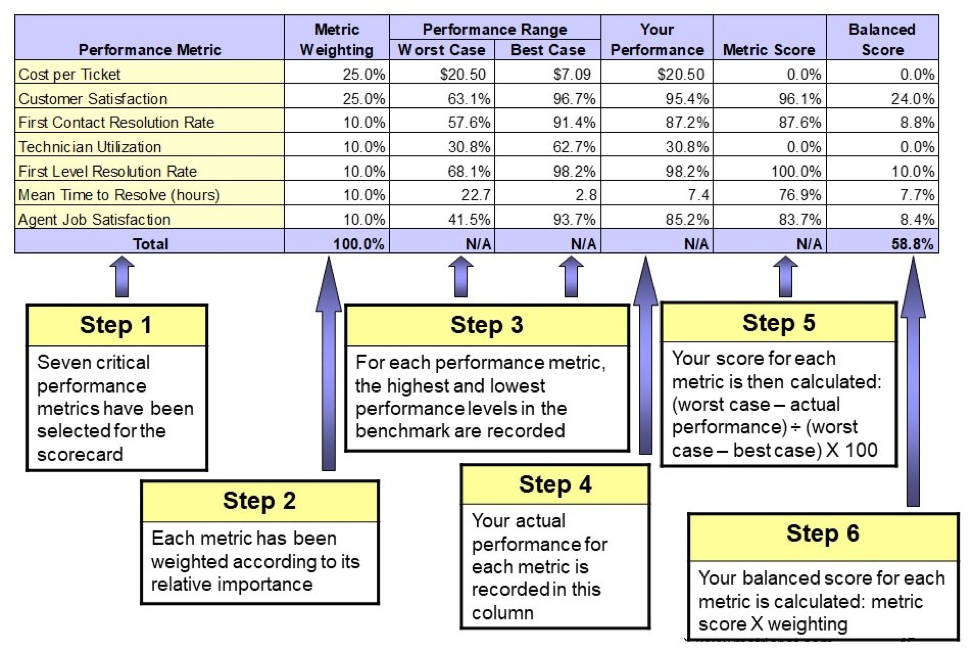
How to score ITSM metrics. Credit: techbeacon.com
Use IT service management to stay ahead
Selecting an effective ITSM framework and setting up a robust IT team is essential for firms to ensure they’re ready to face the ever-evolving challenges and opportunities involved in IT service delivery and support. Before you make a decision, it’s important to be aware of the advantages and drawbacks of implementing IT service management and have clear expectations about what you want to get out of the service.
After adopting ITSM, it’s crucial to continuously monitor metrics to gauge what’s working and what isn’t. Deep-diving into KPIs helps you pinpoint successful tactics which you should stick with and failing methods which need to be adjusted. It’s not enough to implement ITSM and sit back. For your organization to truly benefit from the modern approach, it’s important you measure your success and failures.
For most organizations, adopting an ITSM infrastructure will help future-proof the firm. With the increasing pace of business and IT changes, organizations need to do everything they can to stay ahead of the competition, or face the risks associated with getting left behind.

